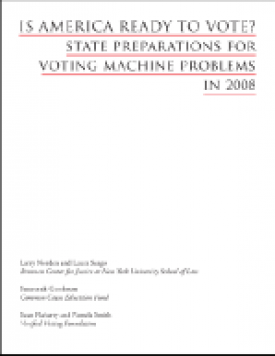Is America Ready to Vote? State Preparations for Voting System Problems in 2008
Resource type: Research Report
Brennan Center for Justice; Common Cause Education Fund; Verified Voting Foundation |
This 2008 report by the Brennan Center for Justice looks at the laws, regulations and procedures of all 50 states and the District of Columbia in four key areas related to their preparedness for voting system failure. The Brennan Center is a grantee of The Atlantic Philanthropies.
On November 4, 2008 voting systems will fail somewhere in the United States in one or more jurisdictions in the country. Unfortunately, we don’t know where. For this reason, it is imperative that every state prepare for system failures. We urge each state to take steps necessary to insure that inevitable voting machine problems do not undermine either the individual right to vote, or our ability to accurately count each vote cast.
Is America Ready to Vote? State Preparations for Voting Machine Problems in 2008 asks what steps each state has put into place to insure against disenfranchisement in the event of election system failures. These might include broken machines, damaged voting system cartridges, software glitches, misprogrammed tally servers, and a range of other likely troubles.
This report does not look at the steps that all states should take to minimize risk of mechanical failures. (most notably, we do not consider pre-election testing which helps insure that machines work properly. This subject has been explored by experts in the recent past (see links: here and here).
Rather, the report assumes that, even with the best voting protocols, occasional machine failures are inevitable.
The report looks at the laws, regulations and procedures of all 50 states and the District of Columbia in four key areas related to their preparedness for voting system failure. We have focused on four distinct areas:
- Polling Place Contingency Plans: Repair of Machines and Emergency Paper BallotsTwenty-four states have some counties that use electronic voting machines or lever machines as their primary voting system on Election Day. If machines in these counties fail, as they have in the past, voters may have to wait in long lines as election workers scramble to repair mechanical troubles. The best prophalytic against injury thus caused is to equip each polling place with emergency paper ballots that can be distributed to voters while machines are out of commission.
- Requirements for Sound Ballot Accounting and Vote Reconciliation. Ballot accounting and reconciliation practices help ensure that the number of ballots cast matches the number of voters who have voted, and that no votes are lost. By checking the number of people who signed in at the poll books against totals reported by the voting machines, by double checking that all absentee votes were counted and every machine’s total included in the statewide tally, and by accounting for all votes used and unused, jurisdictions can catch the kinds of glitches and failures that have resulted in incorrect totals in several past elections.
- Use of a Voting System with a Voter Verifiable Paper Record. Nearly every state in the country counts its votes on some form of electronic voting system. But 19 states use machines that have no voter-verifiable paper record. These help guard against the possibility that corrupt software or programming errors will result in an incorrect machine total.
- Conducts Post-Election Audit of Voter Verifiable Paper Record. Mandatory comparison of some percentage of the paper ballots to electronic totals is one of the best ways to ensure that the electronic totals reported by voting machines are accurate.
Six states received the best rankings (between “generally good” and “excellent”) in all relevant categories: Alaska, California, Minnesota, Missouri, North Carolina, and Oregon. Ten states received the worst rankings (“needs improvement” or “inadequate”) in three of four categories: Colorado, Delaware, Kentucky, Louisiana, New Jersey, South Carolina, Tennessee, Texas, Utah, Virginia
